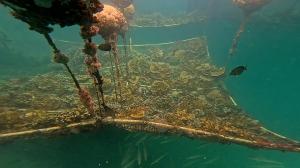VNR: UH-developed, living coastal-protection system prepares for deployment
University of Hawaiʻi at MānoaLink to video and sound: https://go.hawaii.edu/S8a
WHAT: A milestone in the University of Hawaiʻi Rapid Resilient Reefs for Coastal Defense (R3D) project to create a living breakwater system, inspired by natural reefs, to protect coastlines from erosion, while also creating ecosystems where coral and other ocean life will grow and thrive.
The project is funded by a $27 million, 5-year award from the U.S. Department of Defense through the Defense Advanced Research Projects Agency (DARPA).
WHO: Applied Research Laboratory at UH (ARL at UH), UH Mānoa’s School of Ocean and Earth Science and Technology (SOEST): Hawaiʻi Institute of Marine Biology (HIMB) and Department of Ocean and Resources Engineering in partnership with University of California San Diego / Scripps Institution of Oceanography, Florida Atlantic University, Ohio State University and our industry partner Makai Ocean Engineering located here in Hawaiʻi.
PROJECT MILESTONE: The completion of the first concrete reef prototype that feature large holes to dissipate wave energy and are designed to promote coral growth. Full production on 60 units is underway.
- Reef Crest structures (20 ft long x 8 ft wide x 7.7 ft high, 11.7 US tons) will bear the brunt of the larger waves and will be anchored to the seabed to prevent them from moving during larger-wave events.
- Back Reef structures (13.6 ft diameter x 5.2 ft tall, 4.4 US tons) will rest in calmer environments.
WHEN: In late 2024, early 2025, a 50-meter array of the reef structures will be deployed near Ulupaʻu crater, located on the Kailua Bay side of Marine Corps Base Hawaiʻi.
WHERE: The concrete structures are being constructed at two precast concrete yards in Kapolei on Oʻahu. The climate-resilient corals were bred and coral settlement modules were designed at HIMB at Moku o Lo‘e in Kāneʻohe Bay.
WHY: The goal of the living breakwater system is to counter the impact of climate change and warming ocean temperatures that are killing the world’s reefs, which play a critical role in coastal protection and ocean ecosystems, a major source of food and shelter.
ADDITIONAL INFO:
- Components to the project include:
- Design and construction of the concrete structures
- Design and construction of coral settlement modules, complex habitat shapes that will be placed on the structure that mimic natural coral reefs, with specific crevice sizes and depths that promote larval coral settlement, and provide areas for other ocean life to grow and a refuge for fish.
- Development of biological and chemical cues to encourage natural coral settlement.
- Identifying and propagating corals resilient to climate change for the outplanting of coral on the reef structure.
- Acoustics on the structure that mimic the sound of healthy coral reefs to attract coral and fish.
- When deployed, the array will be placed in relatively smooth areas of degraded reefs, leveraging the natural shape of the seafloor. The structures will sit just below the water’s surface, preserving the areas’ natural aesthetics and will also be able to bear the brunt of the larger waves.
- After the deployment, the research team will monitor the site and will immediately be able to measure the reduction in wave energy. It will take a few years to measure the success of the growth of the resilient coral and ecosystem.
- Coral reefs absorb up to 97% of wave energy and play a critical role in coastal protection around the world.
- More than half of the world’s coral reefs have perished, and 90% of the remaining reefs are projected to die within the next century due to climate change and warming ocean temperatures.
- R3D is one of many research projects that led to UH setting a record in extramural funding awarded, with $615.7 million in fiscal year 2024 (FY2024).
B-ROLL (1 minutes, 50 seconds)
- :00 - :27 - Reef structures constructed at precast concrete yards in Kapolei, Oʻahu
- :27 - :55 - Diver at HIMB installing coral on the coral settlement modules prototypes
- :55 - 1:08 - 3D printed coral settlement module prototypes at HIMB
- 1:08 - 1:50 - Reef nursery at HIMB testing resilience of various types of coral
SOUNDBITES:
Ben Jones, Applied Research Laboratory at UH Director of Ocean Science and Technology (:17)
“The rapid resilient reefs for coastal defense project is a project that aims to really redesign how we do coastal protection. So, specifically, we're looking at how to engineer a living breakwater system to protect coastlines.”
Jones (:12)
“This is an opportunity to kind of reinvent how we protect the coast. And at the same time, encourage the ecosystem to recover and to even thrive.”
Zhenhua Huang, UH Mānoa Ocean and Resources Engineering Professor (:20)
“This is a really great project, a true interdisciplinary project. So I myself am a coastal engineer. Now, I'm working with marine biology. This is a totally different field. So, we work together to achieve this common goal that is to come up with a solution that is nature based.”
Robert Toonen, UH Mānoa Hawaiʻi Institute of Marine Biology research professor (:12)
“The adaptive biology part of it is focused on how we get corals onto the structure that are going to survive marine heat waves and future climate change.”
Joshua Madin, UH Mānoa Hawaiʻi Institute of Marine Biology research professor (:15)
“We put out these structures with special crevices and cracks and crannies that we've noticed through multiple generations of design that coral babies just love. We kind of reverse engineered the reef to find out what they love about the reef.”

